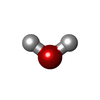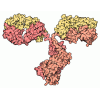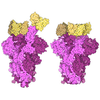+ Open data
Open data
- Basic information
Basic information
| Entry | Database: PDB / ID: 9pkv | ||||||
|---|---|---|---|---|---|---|---|
| Title | HU-38 Fab with PRAME pMHC | ||||||
 Components Components |
| ||||||
 Keywords Keywords | PEPTIDE BINDING PROTEIN/IMMUNE SYSTEM / PRAME / pMHC / PEPTIDE BINDING PROTEIN / PEPTIDE BINDING PROTEIN-IMMUNE SYSTEM complex | ||||||
| Function / homology |  Function and homology information Function and homology informationnegative regulation of receptor binding / early endosome lumen / Nef mediated downregulation of MHC class I complex cell surface expression / DAP12 interactions / transferrin transport / cellular response to iron ion / Endosomal/Vacuolar pathway / Antigen Presentation: Folding, assembly and peptide loading of class I MHC / peptide antigen assembly with MHC class II protein complex / cellular response to iron(III) ion ...negative regulation of receptor binding / early endosome lumen / Nef mediated downregulation of MHC class I complex cell surface expression / DAP12 interactions / transferrin transport / cellular response to iron ion / Endosomal/Vacuolar pathway / Antigen Presentation: Folding, assembly and peptide loading of class I MHC / peptide antigen assembly with MHC class II protein complex / cellular response to iron(III) ion / MHC class II protein complex / negative regulation of forebrain neuron differentiation / antigen processing and presentation of exogenous protein antigen via MHC class Ib, TAP-dependent / ER to Golgi transport vesicle membrane / peptide antigen assembly with MHC class I protein complex / regulation of iron ion transport / regulation of erythrocyte differentiation / HFE-transferrin receptor complex / response to molecule of bacterial origin / MHC class I peptide loading complex / T cell mediated cytotoxicity / positive regulation of T cell cytokine production / antigen processing and presentation of endogenous peptide antigen via MHC class I / antigen processing and presentation of exogenous peptide antigen via MHC class II / positive regulation of immune response / MHC class I protein complex / positive regulation of T cell activation / peptide antigen binding / positive regulation of receptor-mediated endocytosis / negative regulation of neurogenesis / cellular response to nicotine / positive regulation of T cell mediated cytotoxicity / multicellular organismal-level iron ion homeostasis / specific granule lumen / phagocytic vesicle membrane / recycling endosome membrane / Interferon gamma signaling / Immunoregulatory interactions between a Lymphoid and a non-Lymphoid cell / negative regulation of epithelial cell proliferation / MHC class II protein complex binding / Modulation by Mtb of host immune system / late endosome membrane / sensory perception of smell / positive regulation of cellular senescence / tertiary granule lumen / DAP12 signaling / T cell differentiation in thymus / negative regulation of neuron projection development / ER-Phagosome pathway / protein refolding / early endosome membrane / protein homotetramerization / amyloid fibril formation / intracellular iron ion homeostasis / learning or memory / endoplasmic reticulum lumen / Amyloid fiber formation / Golgi membrane / lysosomal membrane / external side of plasma membrane / focal adhesion / Neutrophil degranulation / SARS-CoV-2 activates/modulates innate and adaptive immune responses / structural molecule activity / endoplasmic reticulum / Golgi apparatus / protein homodimerization activity / extracellular space / extracellular exosome / extracellular region / identical protein binding / membrane / plasma membrane / cytosol Similarity search - Function | ||||||
| Biological species |  Homo sapiens (human) Homo sapiens (human)  | ||||||
| Method | ELECTRON MICROSCOPY / single particle reconstruction / cryo EM / Resolution: 2.72 Å | ||||||
 Authors Authors | Mortenson, D.E. / Yu, X. | ||||||
| Funding support | 1items
| ||||||
 Citation Citation |  Journal: MAbs / Year: 2025 Journal: MAbs / Year: 2025Title: A highly selective TCR-mimic antibody reveals unexpected mechanisms of HBV peptide-MHC recognition and previously unknown target biology. Authors: Shahzada Khan / Jeremy Lum / Heather Stephenson / Pawan Bir Kohli / David Mortenson / Dhivya Ramakrishnan / Magdeleine Hung / Sheng Ding / Elbert Seto / Sabrina Lu / Randy Yen / Debi Jin / ...Authors: Shahzada Khan / Jeremy Lum / Heather Stephenson / Pawan Bir Kohli / David Mortenson / Dhivya Ramakrishnan / Magdeleine Hung / Sheng Ding / Elbert Seto / Sabrina Lu / Randy Yen / Debi Jin / Brian Lee / Sheila Clancy / Nicole Schirle Oakdale / Nikolai Novikov / Don Kang / Ruidong Li / David Pan / Rutwij Dave / Eric Lansdon / Simon P Fletcher / Abhishek V Garg / Nathan Thomsen / Scott Balsitis /  Abstract: Curative therapies for chronic hepatitis B virus infection (CHB) are needed, and T-cell redirection is a promising approach, with peptide-MHC complexes (pMHC) being attractive targets. HBV core ...Curative therapies for chronic hepatitis B virus infection (CHB) are needed, and T-cell redirection is a promising approach, with peptide-MHC complexes (pMHC) being attractive targets. HBV core peptide (C18, 10-mer) presented by HLA-A*02:01 (C18-MHC) has two major variants (C18-V or C18-I, differing in the C-terminal residue), both of which are known to be targeted by CD8 T cells in HBV-infected individuals. Through an extensive screening campaign, we identified a highly selective anti-C18-MHC antibody clone MUR35. A MUR35-based T-cell engager (TCE) potently killed HBV-infected hepatocytes but had no activity on uninfected hepatocytes, on other HBV-negative cell types or on host peptides with sequence similarity to C18. Crystal structures of MUR35 bound to both C18-I- and C18-V-MHC revealed a unique binding mode with contacts mediated exclusively by the light chain complementarity-determining regions (CDRs), suggesting that high specificity is achievable without a typical T-cell receptor-like binding mode involving both heavy and light chain CDRs. Although MUR35 exhibits similar binding affinity and structural contacts with C18-V and C18-I, TCE killing was only detected on hepatocytes producing C18-V. To better understand the cause of this discrepancy, we conducted a quantitative proteomics study in an HBV-infected humanized mouse model and found that C18-V was expressed at approximately 300 copies/cell, while C18-I expression was below the limit of detection. Unexpectedly, the proteomics studies revealed that previously unreported 9-mers missing the N-terminal phenylalanine of C18-I and -V were expressed at an average of 508 and 142 copies/cell, respectively, and therefore could be alternative targets for HBV pan genotypic coverage. Our data suggest unexpectedly large differences in antigen presentation efficiency between highly conservative amino acid substitutions in C18 peptide and reveal potentially novel HBV targets for future studies. | ||||||
| History |
|
- Structure visualization
Structure visualization
| Structure viewer | Molecule:  Molmil Molmil Jmol/JSmol Jmol/JSmol |
|---|
- Downloads & links
Downloads & links
- Download
Download
| PDBx/mmCIF format |  9pkv.cif.gz 9pkv.cif.gz | 193.6 KB | Display |  PDBx/mmCIF format PDBx/mmCIF format |
|---|---|---|---|---|
| PDB format |  pdb9pkv.ent.gz pdb9pkv.ent.gz | 147.4 KB | Display |  PDB format PDB format |
| PDBx/mmJSON format |  9pkv.json.gz 9pkv.json.gz | Tree view |  PDBx/mmJSON format PDBx/mmJSON format | |
| Others |  Other downloads Other downloads |
-Validation report
| Summary document |  9pkv_validation.pdf.gz 9pkv_validation.pdf.gz | 1.4 MB | Display |  wwPDB validaton report wwPDB validaton report |
|---|---|---|---|---|
| Full document |  9pkv_full_validation.pdf.gz 9pkv_full_validation.pdf.gz | 1.4 MB | Display | |
| Data in XML |  9pkv_validation.xml.gz 9pkv_validation.xml.gz | 44.1 KB | Display | |
| Data in CIF |  9pkv_validation.cif.gz 9pkv_validation.cif.gz | 65.7 KB | Display | |
| Arichive directory |  https://data.pdbj.org/pub/pdb/validation_reports/pk/9pkv https://data.pdbj.org/pub/pdb/validation_reports/pk/9pkv ftp://data.pdbj.org/pub/pdb/validation_reports/pk/9pkv ftp://data.pdbj.org/pub/pdb/validation_reports/pk/9pkv | HTTPS FTP |
-Related structure data
| Related structure data |  71704MC  9pixC  9pkcC  9pkfC M: map data used to model this data C: citing same article ( |
|---|---|
| Similar structure data | Similarity search - Function & homology  F&H Search F&H Search |
- Links
Links
- Assembly
Assembly
| Deposited unit | 
|
|---|---|
| 1 |
|
- Components
Components
-Protein , 2 types, 2 molecules AB
| #1: Protein | Mass: 34359.895 Da / Num. of mol.: 1 Source method: isolated from a genetically manipulated source Source: (gene. exp.)  Homo sapiens (human) / Gene: HLA-A / Production host: Homo sapiens (human) / Gene: HLA-A / Production host:  |
|---|---|
| #5: Protein | Mass: 11879.356 Da / Num. of mol.: 1 / Fragment: UNP residues 21-119 Source method: isolated from a genetically manipulated source Source: (gene. exp.)  Homo sapiens (human) / Gene: B2M, CDABP0092, HDCMA22P / Production host: Homo sapiens (human) / Gene: B2M, CDABP0092, HDCMA22P / Production host:  |
-Antibody , 3 types, 3 molecules KHL
| #2: Antibody | Mass: 13246.515 Da / Num. of mol.: 1 Source method: isolated from a genetically manipulated source Source: (gene. exp.)   |
|---|---|
| #4: Antibody | Mass: 25680.639 Da / Num. of mol.: 1 Source method: isolated from a genetically manipulated source Source: (gene. exp.)   Homo sapiens (human) Homo sapiens (human) |
| #6: Antibody | Mass: 23287.822 Da / Num. of mol.: 1 Source method: isolated from a genetically manipulated source Source: (gene. exp.)   Homo sapiens (human) Homo sapiens (human) |
-Protein/peptide / Non-polymers , 2 types, 192 molecules P

| #3: Protein/peptide | Mass: 994.209 Da / Num. of mol.: 1 / Source method: obtained synthetically / Source: (synth.)  Homo sapiens (human) Homo sapiens (human) |
|---|---|
| #7: Water | ChemComp-HOH / |
-Details
| Has ligand of interest | N |
|---|---|
| Has protein modification | Y |
-Experimental details
-Experiment
| Experiment | Method: ELECTRON MICROSCOPY |
|---|---|
| EM experiment | Aggregation state: PARTICLE / 3D reconstruction method: single particle reconstruction |
- Sample preparation
Sample preparation
| Component | Name: complex of HU38 Fab with PRAME pMHC and anti-Kappa VHH Type: COMPLEX / Entity ID: #1-#6 / Source: MULTIPLE SOURCES |
|---|---|
| Molecular weight | Experimental value: NO |
| Source (natural) | Organism:  Homo sapiens (human) Homo sapiens (human) |
| Source (recombinant) | Organism:  |
| Buffer solution | pH: 7.4 |
| Specimen | Embedding applied: NO / Shadowing applied: NO / Staining applied: NO / Vitrification applied: YES |
| Vitrification | Instrument: FEI VITROBOT MARK IV / Cryogen name: ETHANE / Humidity: 100 % / Chamber temperature: 10 K |
- Electron microscopy imaging
Electron microscopy imaging
| Experimental equipment |  Model: Titan Krios / Image courtesy: FEI Company |
|---|---|
| Microscopy | Model: TFS KRIOS |
| Electron gun | Electron source:  FIELD EMISSION GUN / Accelerating voltage: 300 kV / Illumination mode: SPOT SCAN FIELD EMISSION GUN / Accelerating voltage: 300 kV / Illumination mode: SPOT SCAN |
| Electron lens | Mode: BRIGHT FIELD / Nominal defocus max: 2000 nm / Nominal defocus min: 800 nm / Cs: 2.7 mm |
| Image recording | Electron dose: 50 e/Å2 / Film or detector model: GATAN K3 (6k x 4k) |
- Processing
Processing
| EM software |
| ||||||||||||||||||||
|---|---|---|---|---|---|---|---|---|---|---|---|---|---|---|---|---|---|---|---|---|---|
| CTF correction | Type: PHASE FLIPPING AND AMPLITUDE CORRECTION | ||||||||||||||||||||
| 3D reconstruction | Resolution: 2.72 Å / Resolution method: FSC 0.143 CUT-OFF / Num. of particles: 553793 / Symmetry type: POINT |
 Movie
Movie Controller
Controller



 PDBj
PDBj



